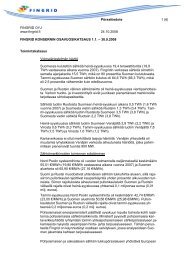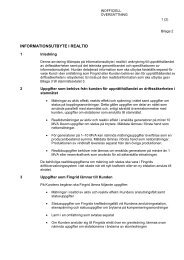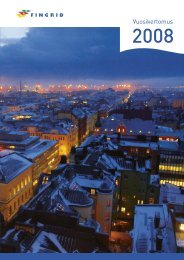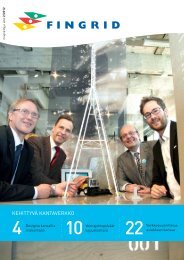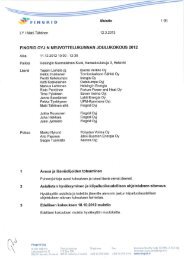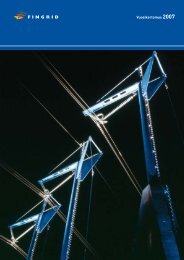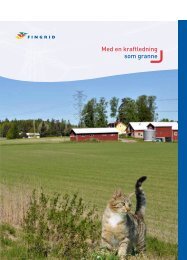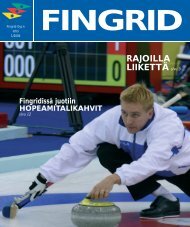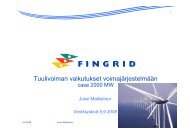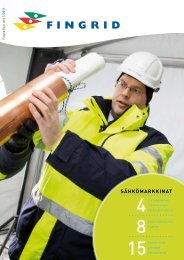Living adjacent to a transmission line - Fingrid
Living adjacent to a transmission line - Fingrid
Living adjacent to a transmission line - Fingrid
Create successful ePaper yourself
Turn your PDF publications into a flip-book with our unique Google optimized e-Paper software.
Let’s stay on good termsAn electricity <strong>transmission</strong> <strong>line</strong> is a neighbourwhich does not wish <strong>to</strong> disturb others or be disturbed.This brochure contains information andsafety instructions, which make living <strong>adjacent</strong> <strong>to</strong>a <strong>transmission</strong> <strong>line</strong> safe and trouble-free.FINGRID HAS A RIGHT TO USE THE LINE AREAS<strong>Fingrid</strong> does not own the land areas under the<strong>transmission</strong> <strong>line</strong>s or the trees located withinthese areas. These are property of the landowner.Through expropriation, <strong>Fingrid</strong> has acquired apermanent right <strong>to</strong> use the <strong>transmission</strong> <strong>line</strong> area.This gives the company a right <strong>to</strong> for example usethe <strong>transmission</strong> <strong>line</strong> area, restrict building in thearea, clear vegetation in the area, and manageexcessively tall trees in the border zone.The company’s right and obligation <strong>to</strong> give theinstructions presented in this brochure is basedon the Electrical Safety Act and on the expropriationof the <strong>transmission</strong> <strong>line</strong> area on the basis of apermit given by the Council of State.COMPENSATION PAID TO LANDOWNERSFOR THE USE OF THE LINE AREAA lump-sum compensation determined in theexpropriation proceedings is paid for the right ofuse of the <strong>transmission</strong> <strong>line</strong> area. <strong>Fingrid</strong> does notdecide on the expropriation compensations, butthese are specified by an impartial expropriationcommittee in accordance with the act concerningexpropriation.If a landowner suffers disadvantage or damage inconjunction with the maintenance of the <strong>transmission</strong><strong>line</strong>, these cases are agreed upon with thelandowner individually in each case.20 mBorder zone10 m10 mRight of wayTransmission <strong>line</strong> areaBuilding prohibition zoneBorder zoneThe width of an 110 kV right of way is generally 26–30 m.The width of a 220 kV right of way is generally 32–38 m.The width of a 400 kV right of way is generally 36–42 m.20 mThe width of the border zone is 10 metres on both sides of the <strong>line</strong>, always a <strong>to</strong>tal of 20 metres.UNDERGROUND STRUCTURESOverhead earth wireEarth wire peakCrossarmInsula<strong>to</strong>r stringInsula<strong>to</strong>r unitPhase conduc<strong>to</strong>rHorizontal braceROBUST BUT USEFUL NEIGHBOURThe <strong>transmission</strong> <strong>line</strong> area is the area for whichThe <strong>to</strong>wer area ofFoundation4 <strong>Fingrid</strong> has expropriated a right of use. The right ofa <strong>transmission</strong> <strong>line</strong>5Ground electrodeuse imposes usage restrictions on the landowner.<strong>to</strong>wer extends over aGuy anchordistance ofThe voltage levels of <strong>transmission</strong> <strong>line</strong>s in Finland3 metres from theare 110, 220 and 400 kilovolts (kV)*. The voltageoverground <strong>to</strong>werThe <strong>to</strong>wer type shown in the picture is the mostlevel can be recognised by the length of the insula<strong>to</strong>rstring and the number of insula<strong>to</strong>r discs:supporting steel <strong>to</strong>wers without guys are alsostructures.commonly used guyed portal <strong>to</strong>wer, but so-called self-used.Voltage levelkVLength ofinsula<strong>to</strong>r stringNumber ofinsula<strong>to</strong>r discs110 approx. 1 metre 6–8220 approx. 2 metres 10–12400 approx. 4 metres 18–21*1 kV = 1,000 volts (V)3 m3 m 3 m3 mCENTRE LINE OF TRANSMISSION LINELegGuyNumber plateA guyed two-legged portal <strong>to</strong>wer.CENTRE LINE OF TRANSMISSION LINE3 m3 m3 m 3 mA single-legged steel lattice<strong>to</strong>wer without guys.
Taking care of the <strong>line</strong>sTRANSMISSION LINE INSPECTIONS CONSTITUTETHE BASIS FOR MAINTENANCEAs the owner of the <strong>transmission</strong> <strong>line</strong>, <strong>Fingrid</strong> hasan obligation <strong>to</strong> maintain the <strong>line</strong> in the conditionprescribed by electric safety regulations. In order<strong>to</strong> fulfil this obligation, the company’s employeesand service providers have the right <strong>to</strong> move inthe <strong>transmission</strong> <strong>line</strong> area on foot and by usingmachinery and vehicles, <strong>to</strong> use roads and pathsleading <strong>to</strong> the <strong>transmission</strong> <strong>line</strong> area and <strong>to</strong> useother areas, if necessary. The condition of the<strong>transmission</strong> <strong>line</strong> and the height of vegetation inthe <strong>transmission</strong> <strong>line</strong> area are moni<strong>to</strong>red with thehelp of inspections carried out at intervals of 1 <strong>to</strong>3 years.The inspections are used for observing issues such as:- vegetation in the <strong>transmission</strong> <strong>line</strong> area, newstructures, excavations- potential inclination of <strong>to</strong>wer structures, conditionof steel parts- grounding and foundations- condition of insula<strong>to</strong>rs and conduc<strong>to</strong>rs.In the winter, snow accumulating on the conduc<strong>to</strong>rsis removed whenever necessary.REGULAR MANAGEMENT OF TREESGUARANTEES RELIABILITYTrees in the right-of-way are cleared mechanicallyor manually every 5 <strong>to</strong> 8 years.Trees in the border zones of <strong>transmission</strong> <strong>line</strong>s aremanaged at intervals of 10 <strong>to</strong> 25 years. Excessivelytall trees are felled or their <strong>to</strong>ps are cut by 2 <strong>to</strong> 4metres by means of a helicopter. Trees <strong>to</strong>p-endedwith helicopter sawing do not need <strong>to</strong> be harvestedright away. Decay in a tree with a cut <strong>to</strong>pprogresses so slowly that decay damage does notreduce the value of timber if its felling is combinedwith the logging of some <strong>adjacent</strong> forestarea in the coming years. It is also worthwhile loggingborder zone trees, whose <strong>to</strong>ps have not beencut, at the same time.<strong>Fingrid</strong> informs landowners by letter of the clearingof rights-of-ways and management of trees inthe border zones.If there is a need <strong>to</strong> fell the trees in the borderzone, <strong>Fingrid</strong> endeavours <strong>to</strong> arrange joint fellingand sales of the timber. However, as the owner ofthe trees, the landowner has a right <strong>to</strong> decide how<strong>to</strong> arrange the harvesting and sales of border zonetrees, which need <strong>to</strong> be felled because of <strong>transmission</strong><strong>line</strong> maintenance. In any case, it is important<strong>to</strong> remember that logging close <strong>to</strong> a <strong>transmission</strong><strong>line</strong> requires special professional skills, and landownersshould not do this on their own.If most of the trees in the border zone are <strong>to</strong>o tall,it is usually most sensible <strong>to</strong> use <strong>to</strong>tal manage-6ment of the border zone so that all other treesexcept those that are considerably shorter than the 7trees shown in the diagram on page 5 are felled inthe border zone.Forest management for the border zones of <strong>transmission</strong><strong>line</strong> areas involves many special features,which should be taken in<strong>to</strong> account when decidingon the forest regeneration and managementmeasures. In order <strong>to</strong> enhance forest managementin these special areas, Forestry DevelopmentCentre Tapio has drawn up forest managementrecommendations for border zones. These recommendationsare presented in a forest managementcard, which can be downloaded (in Finnish) from<strong>Fingrid</strong>’s website.COMPENSATIONS FOR THE USE OF PRIVATE ROADS<strong>Fingrid</strong> signs 10-year maintenance road agreementswith road owners on the use of privateroads leading <strong>to</strong> the <strong>transmission</strong> <strong>line</strong> areas.<strong>Fingrid</strong>, the Central Union of Agricultural Producersand Forest Owners (MTK) and the CentralUnion of Swedish-Speaking Agricultural Producersin Finland (SLC) have drawn up a compensationrecommendation concerning the use of privateroads. Among other things, the recommendationspecifies the unit prices of road usage fees forvarious usage categories.
IF A TREE BEGINS TO FALL TOWARDS A TRANS-MISSION LINE DESPITE PRECAUTIONS, FOLLOWTHESE INSTRUCTIONS:Interrupt your work immediately.Bound so that only one foot <strong>to</strong>uches theground at a time and proceed <strong>to</strong> a distanceof at least 20 metres from the tree asquickly as possible.If a falling tree hits the <strong>line</strong> or gets caughtin the conduc<strong>to</strong>rs, notify <strong>Fingrid</strong>’s NetworkWhat you need <strong>to</strong> know before you do anythingFELLING OF TREES AND STORAGE OF TIMBERNear a <strong>transmission</strong> <strong>line</strong>, the trees must notbe cut <strong>to</strong>wards the <strong>line</strong>. Always verify thecorrect felling direction in accordance withthe safety instructions for timber harvestingwork. If necessary, <strong>Fingrid</strong> will provide furtherinformation and felling assistance.For safety reasons, timber or energy woodmust not be s<strong>to</strong>red under a <strong>transmission</strong> <strong>line</strong>or nearer than 10 metres from the closestphase conduc<strong>to</strong>r of the <strong>line</strong> in the horizontaldirection.Control Centre (tel. 030 395 4300) of thisSAFE USE OF MACHINERY8 immediately or call the nation-wide emer-Ordinary agricultural machinery can be operated9Voltage Minimum distance Minimum distancegency number 112.under a <strong>transmission</strong> <strong>line</strong>. Caution must be exercisedwhen operating agricultural machinery near trans mission or load beneath from phaselevel of <strong>to</strong> machinery <strong>to</strong> machinery or loadMake sure that nobody goes close <strong>to</strong> thesuspended tree.the <strong>to</strong>wer structures. If, however, <strong>to</strong>wer structures<strong>line</strong> phase conduc<strong>to</strong>rs conduc<strong>to</strong>rs inhorizontal directionare damaged, inform <strong>Fingrid</strong> immediately.DO NOT TRY TO LOOSEN A TREE WHICH TOUCHES110 kV 3 metres 5 metresPHASE CONDUCTORS BEFORE:If you are using an excava<strong>to</strong>r, crane or other220 kV 4 metres 5 metresthe <strong>line</strong> has been de-energised,machinery near a <strong>transmission</strong> <strong>line</strong>, make sure400 kV 5 metres 5 metresthe <strong>line</strong> has been provided with workthat you do not end up <strong>to</strong>o close <strong>to</strong> the live phasegrounding, andconduc<strong>to</strong>rs. No machinery must be brought in<strong>to</strong> IF THE LOADER OR LOAD TOUCHES THE CONDUCthe<strong>to</strong>wer area.you obtain permission from the owner ofTORS WHILE USING MACHINERY, PROCEED ASFOLLOWS:the <strong>line</strong> <strong>to</strong> loosen the tree.The table below presents the permitted minimumdistances of machinery with potential load fromYou are initially safe inside the cabin.the phase conduc<strong>to</strong>rs of a <strong>transmission</strong> <strong>line</strong>.Try <strong>to</strong> run the machine off the <strong>transmission</strong> <strong>line</strong>.If the machine catches fire or if its tyresstart <strong>to</strong> smoke, jump out of the machineNever drive machinery between the <strong>to</strong>wer legs,under a guy wire, or closer than 3 metres fromso that both of your feet <strong>to</strong>uch the groundthe <strong>to</strong>wer structures!simultaneously.Do not <strong>to</strong>uch the machine and groundTrees located close <strong>to</strong> a <strong>transmission</strong> <strong>line</strong>simultaneously.should always be felled by professionals.Bound so that only one foot <strong>to</strong>uches theground at a time and proceed <strong>to</strong> a distanceof at least 20 metres from the machine asfast as possible.Contact <strong>Fingrid</strong> immediately even if the<strong>transmission</strong> <strong>line</strong> is not visibly damaged.Make sure that nobody can access the area.5 metres110 kV 3 metres220 kV 4 metres400 kV 5 metres
10 11SAFE CULTIVATION AND PASTURAGEA right-of-way can be used for cultivation, anddomestic animals can graze safely in the area. Itcan also be used as a vegetable garden, and forexample berry bushes can be planted there. Whenplanting bushes, leave a passage in the centre <strong>line</strong>of the <strong>transmission</strong> <strong>line</strong> so that <strong>line</strong> inspec<strong>to</strong>rs andmaintenance personnel can either walk or movetheir machinery from one <strong>to</strong>wer <strong>to</strong> another. Fruittrees and Christmas trees can be cultivated in aright-of-way just as long as their height remainswithin the permitted limits. Growing of trees mustbe agreed upon with <strong>Fingrid</strong> through a growthclearance area contract.MAKE SURE THAT ROW COVERS STAY IN PLACEIf a planted area is covered with protective rowcovers, use weights or other fasteners <strong>to</strong> makesure that the covers will stay in place also whenthere is a gusty and strong wind. Warming of airunder the cover causes a buoyant effect, whichmay loosen the cover and send it flying high in<strong>to</strong>the air. If, despite precautions, covers fly on<strong>to</strong> the<strong>transmission</strong> <strong>line</strong> structures, never try <strong>to</strong> removethem yourself. <strong>Fingrid</strong> must be notified accordinglywithout delay.Remember that the “fuse” never blows in a highvoltage<strong>transmission</strong> <strong>line</strong>; it is always dangerous!More detailed advice for grounding matters isavailable from <strong>Fingrid</strong>.MAKING OF OPEN FIRE IS PROHIBITEDFor safety reasons, it is forbidden <strong>to</strong> make an openfire under a <strong>transmission</strong> <strong>line</strong> or in its immediatevicinity. If you intend <strong>to</strong> burn grass within a distanceof less than 50 metres from the <strong>line</strong>, contact <strong>Fingrid</strong>.KEEP A FISHING ROD FAR AWAY FROM A LINEIf you are fishing, make sure that neither the rodor the <strong>line</strong> can reach closer than 5 metres from thephase conduc<strong>to</strong>rs of the <strong>transmission</strong> <strong>line</strong>.DO NOT FLY A KITE IN A RIGHT-OF-WAYFor safety reasons, flying a kite is not allowed inthe right-of-way of a <strong>transmission</strong> <strong>line</strong>.TRAMPOLINES AND CLIMBING FRAMESBecause of personal safety, it is forbidden <strong>to</strong> placetrampo<strong>line</strong>s, climbing frames and other devices,which can bring persons higher than the normalground surface, under a <strong>transmission</strong> <strong>line</strong>.DO NOT SPRAY WATER ON THE TRANSMISSION LINEArtificial irrigation systems can be used in thenormal way in the vicinity of a <strong>transmission</strong> <strong>line</strong>just as long as the water jet does not hit the<strong>line</strong>. When setting up, moving and dismantlingirrigation systems, make sure that the irrigationequipment does not come dangerously close <strong>to</strong>the phase conduc<strong>to</strong>rs.If the phase conduc<strong>to</strong>r of a <strong>transmission</strong> <strong>line</strong>is broken or otherwise hanging close <strong>to</strong> theground, it is highly dangerous <strong>to</strong> go near theconduc<strong>to</strong>r!GROUNDING OF FENCES AND TIN ROOFSNo significant voltages are usually created in abarbed wire fence or a metal wire net fence bythe electric field of a <strong>transmission</strong> <strong>line</strong>. These arewell grounded through fence poles, grass or othervegetation. If the fence runs for a long distanceclose <strong>to</strong> the <strong>transmission</strong> <strong>line</strong> or if the fence isisolated from the ground, a harmful voltage may,however, be created in the fence. In this case, thefence must be grounded.The electric field of the <strong>transmission</strong> <strong>line</strong> may also resultin a charging voltage, which is harmless in itself,being charged in tin roofs located under the <strong>line</strong>.This can also be removed easily by grounding theroof <strong>to</strong> the ground for instance through gutter pipes.FINGRID PROVIDES INSTRUCTIONS FOR BLASTING WORKIf you are going <strong>to</strong> quarry rock or carry out blastingwork within a distance of less than 100 metresfrom the <strong>line</strong>, ask for instructions from <strong>Fingrid</strong>.DO NOT REFUEL MACHINERY NEAR A TRANSMISSION LINEFor the sake of fire safety, avoid refuelling avehicle or other machinery within less than 20metres from a <strong>transmission</strong> <strong>line</strong>.CLIMBING IN TOWERS POSES A DANGER TO LIFEIt is very dangerous and absolutely forbidden <strong>to</strong>climb in <strong>transmission</strong> <strong>line</strong> <strong>to</strong>wers. It is also forbidden<strong>to</strong> attach anything <strong>to</strong> the <strong>to</strong>wers.INFORM FINGRID OF A LINE FAULTThanks <strong>to</strong> regular inspections and maintenance,<strong>line</strong> faults are rare, but they cannot be avoidedcompletely. If you notice a defect or an abnormalphenomenon in a <strong>line</strong>, please notify <strong>Fingrid</strong>’sNetwork Control Centre (tel. 030 395 4300) of thisas soon as possible.
Many ways <strong>to</strong> utilisethe <strong>transmission</strong> <strong>line</strong> areaHUNTINGGood visibility renders <strong>transmission</strong> <strong>line</strong> areas suitedfor hunting. For safety reasons, the shootingplaces must be located so that the <strong>line</strong> structuresare not in the <strong>line</strong> of fire. The erection of hunting<strong>to</strong>wers should be agreed upon in advance with<strong>Fingrid</strong>. Game fields can be established on oldfields located in rights-of-ways. A permit for clearingnew fields should be requested from <strong>Fingrid</strong>.ESTABLISHING A ROAD OR OUTDOOR ROUTEYou can jog and ski in a <strong>transmission</strong> <strong>line</strong> area. Apermit from the landowner and a statement from<strong>Fingrid</strong> are required for the building of a road,outdoor recreation route, jogging track or skiingtrack in a <strong>transmission</strong> <strong>line</strong> area.USE OF SNOWMOBILESWith the landowner’s and <strong>Fingrid</strong>’s permit, a<strong>transmission</strong> <strong>line</strong> area can be used for snowmobileriding. Snowmobile riding is, however, strictly forbiddenin <strong>to</strong>wer areas. A snowmobile route mustbe placed so far from the <strong>to</strong>wers that there is norisk of collision with the <strong>to</strong>wer legs or guys.In addition <strong>to</strong> cultivation and grazing, rights-ofwayscan be utilised in many ways.BUILDINGS AND STRUCTURES<strong>line</strong>. It is advisable <strong>to</strong> inform <strong>Fingrid</strong>, which decideson the placing of power <strong>line</strong> bird markers, of other similar components. The sound caused bynear the surface of conduc<strong>to</strong>rs, insula<strong>to</strong>rs and12It is forbidden <strong>to</strong> construct a building in a13RECREATIONAL USES<strong>transmission</strong> <strong>line</strong> area. If you want <strong>to</strong> build otherlocations where birds collide with a <strong>line</strong>.corona is loudest in moist weather or in the winterA <strong>transmission</strong> <strong>line</strong> area is suited for many types structures such as shelters, roads, parking areas,when hoar frost accumulates on the conduc<strong>to</strong>rs. ItThere has been extensive research on the potentialhealth impacts of the electric and magneticof recreational uses. You can hike and pick berries overhead <strong>line</strong>s, underground cables, water pipes,is practically almost impossible <strong>to</strong> prevent coronaand mushrooms in a <strong>transmission</strong> <strong>line</strong> area. Transmission<strong>line</strong>s also constitute habitats favoured by a permit must be acquired from <strong>Fingrid</strong> for thesewers, lighting posts, flag poles, fish basins etc.,discharge completely, but since the sound is alwaysan indication of energy losses, the goal is <strong>to</strong>fields created around <strong>transmission</strong> <strong>line</strong>s. Based onresearch findings, these fields do not cause a riskbutterflies and many plant species.location and building of these.reduce this phenomenon. Corona occurs mainly at<strong>to</strong> people or animals. Publications on this <strong>to</strong>pic inthe 400 kV voltage level.Finnish can be downloaded from <strong>Fingrid</strong>’s website.Long lighting <strong>line</strong>s and other <strong>line</strong>s laid over theground under a <strong>transmission</strong> <strong>line</strong> may also causea hazard. A permit is also needed if you wish <strong>to</strong>make changes <strong>to</strong> a structure built earlier in the<strong>transmission</strong> <strong>line</strong> area.SOIL EXTRACTION AND DISPOSAL, DITCHINGA permit from <strong>Fingrid</strong> is required for the extractionof gravel, sand, clay, earth and peat in theright-of-way. The same applies <strong>to</strong> ditching andsoil heaps being dumped in a <strong>transmission</strong> <strong>line</strong>area.It is prohibited <strong>to</strong> dig ditches in a <strong>to</strong>wer area.The sides of a ditch must never be closer thanthree metres from the <strong>to</strong>wer and guy structures.If the depth of a ditch <strong>to</strong> be dug is more thanhalf a metre, the underground grounding electrodesmust be taken in<strong>to</strong> account. <strong>Fingrid</strong> mustbe informed immediately of broken groundingelectrodes.Good <strong>to</strong> knowScientific research has not found that <strong>transmission</strong><strong>line</strong>s would have adverse effects on the healthor fertility of pasturing animals. It has not beenestablished that the licking of wooden <strong>to</strong>werswhich have been treated with creosote would havenegative effects on animals. A statement on thisissue has been submitted, among others, by theDepartment of Food and Environmental Hygieneof the University of Veterinary Medicine in Finlandon 25 Oc<strong>to</strong>ber 1994.Power <strong>line</strong> bird markers can be used on theconduc<strong>to</strong>rs near the routes of migra<strong>to</strong>ry birds orin locations where birds nest <strong>to</strong> warn birds of theAccording <strong>to</strong> the Finnish Meteorological Institute,<strong>transmission</strong> <strong>line</strong>s do not increase lightningnor direct the movements of thunder clouds, butthe <strong>line</strong>s actually increase lightning safety. Sincethe <strong>transmission</strong> <strong>line</strong> <strong>to</strong>wers are usually higherthan their immediate environment and sincethey are also grounded, they ”attract” strokes oflightning which would strike in any case in the<strong>adjacent</strong> area.The <strong>line</strong> is constructed so that a stroke of lightningis guided through the overhead ground wirein<strong>to</strong> the ground in a harmless manner. In otherwords, it is not advisable <strong>to</strong> stay in the immediatevicinity of a <strong>transmission</strong> <strong>line</strong> during thunders<strong>to</strong>rm.Transmission <strong>line</strong>s cannot influence the number ofstrokes of lightning, either. Their number dependsentirely on the properties of the thunder cloud,not on the underlying <strong>to</strong>wers.The buzzing sound heard near a <strong>transmission</strong><strong>line</strong> is caused by corona discharge occurring onthe surface of the conduc<strong>to</strong>rs or insula<strong>to</strong>rs. Thecorona phenomenon is harmless <strong>to</strong> people. Thephenomenon is caused by the ionisation of airHigh-voltage <strong>line</strong>s may also cause sounds createdas a result of wind which shakes the various partsof the <strong>line</strong> such as steel <strong>to</strong>wers, conduc<strong>to</strong>rs, crossarmsor insula<strong>to</strong>rs. These sounds occur irrespectiveof whether the <strong>line</strong> is live or not.
Some medical devices inserted in the body (suchas pacemakers) may malfunction under a <strong>transmission</strong><strong>line</strong>. Disturbance in a pacemaker can be reducedthrough adjustments and especially throughthe selection of an appropriate pacemaker.FM radio <strong>transmission</strong> (VHF), i.e. the most commonbroadcast or local radio <strong>transmission</strong>, is notdisturbed by <strong>transmission</strong> <strong>line</strong>s.A <strong>transmission</strong> <strong>line</strong> disturbs the television signalonly in very rare cases. If problems occur, contact<strong>Fingrid</strong>’s experts.A hand-held fluorescent lamp may light up undera <strong>transmission</strong> <strong>line</strong> as a result of the electric fieldcreated by the conduc<strong>to</strong>rs. The current passingthrough the lamp is naturally much weaker thannormally. The lamp glows weakly, and the lightemitted from it cannot be compared <strong>to</strong> the lightemitted in the normal use of the lamp. The lightcan only be seen when it is dusky. This purelyelectric phenomenon does not mean that it wouldcause a health hazard.One of the properties of the electric field of a<strong>transmission</strong> <strong>line</strong> is that electrically conductiveobjects which are isolated from the ground andlocated close <strong>to</strong> the <strong>line</strong> – such as metal shovels,<strong>to</strong>ols etc. – become electrically charged. Anyoneworking under a <strong>line</strong> also becomes electricallycharged. Usually, you do not even notice this, butwhen you are wearing footwear with a thick sole,such as rubber boots, you may feel a faint sparkwhen you <strong>to</strong>uch a grounded object, for instancea metallic fence pole. The phenomenon is similar<strong>to</strong> and as harmless as the spark which is createdwhen taking off a sweater made of synthetic fibres.In the same way, the sparking of an umbrella,for instance, under a <strong>transmission</strong> <strong>line</strong> is harmlessand caused by electric charge.Projects near <strong>transmission</strong><strong>line</strong> requiring permitTHESE ARE NEEDED FOR PERMITS AND STATEMENTS:A map indicating the location of the intendedproject and the <strong>transmission</strong> <strong>line</strong>.A layout drawing indicating the exact locationof the project with respect <strong>to</strong> the <strong>transmission</strong><strong>line</strong>.The name, address and telephone numberof the applicant so that we can obtain additionalinformation if this is necessary.14 15Send the application <strong>to</strong> the below address:<strong>Fingrid</strong> OyjRisteämälausunnotP.O. Box 530FI-00101 Helsinki, Finlandor by e-mail <strong>to</strong>risteamalausunnot@fingrid.fi
FINGRID OYJArkadiankatu 23 B, P.O. Box 530, FI-00101 Helsinki, Finland | Tel. +358 (0)30 395 5000 | Telefax +358 (0)30 395 5196 | www.fingrid.fiHämeenlinna Network Control Centre | Tel. +358 (0)30 395 4300 (24 h duty)



